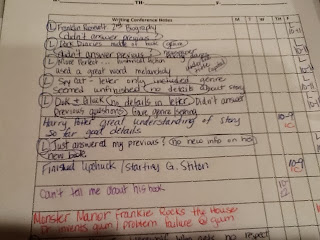Previously our district has used Accelerated Reader for our indpedent reading piece. I had used it for over 10 years and was comfortable with it; however, we never used it to its full potential. I hated that students would only read the books in my library that were marked with an AR sticker and ignore the rest of my fantastic books. I hated the fact that at the beginning of each year I would have to give a disclaimer about not picking books just because they were worth a bunch of points. I hated that kids would read books at the bottom of their reading range just because they could easily earn their points. With this program I never had a conversation with students about what they were reading unless there was a problem.
Well this year we got rid of AR and replaced it with the independent reading modeled in Fontas and Pinnel. This year we are encouraging our students (third and fourth graders) to read 25 books by May 1st. These books are divided up by genres and we are expecting our students to be exposed to many different genres. This was never a focus before, and I am excited to see my students reading many different topics.
What is independent reading you might ask? In our school it is a 20 min. period that we strive to include everyday. It is really hard to fit it all in, and I'll be honest days when I run guided reading centers it doesn't happen. If I can get it in 4 days a week I am stoked. During this 20 min. period students are spread out all over the room with their books and sticky notes. I am conferencing with 4-5 students per period. During a conference I ask about what they are reading. I ask questions based on what we have learned. What genre is your book? Who are the main characters? Could you describe your character's traits? Could you summarize your book or give the main idea? This has been great to see what they are learning in a 1:1 situation. There is no other students to hide behind, it is very enlightening. It is also very personal. Students love the time with you and once you get the process started then they are requesting to conference with you.
I currently have 23 students with me for reading. So I usually have 7-8 students who are writing me a letter in their reading response journal. This counts as their conference for the week. The other 15 I am conferencing with 1:1.
Below you will see how I organize my conferencing notes. I will admit this is not an orginial idea, but a combination of many teachers ideas. The students names are written on post-it notes, then the whole thing is laminated. This keeps the post-its from falling off. Then you lay a new page on top.
 |
I indicate a L for students who are writing me a letter. The rest of the notes are from conferences. I circle things they need help with and this assists me with determining the mini-lesson needed. This process works great because then you have the students in the same order, and essentially have annecdotal records on each student. As you can see, this was early in the process and my students were writing their second letter. They were not answering any questions I had asked in my letter back to them. They had just written me a brand new letter.
 |
 |
| This is a picture of their Reader's Response Notebooks I know it is rotated wrong but I couldn't get it to flip. |
No comments:
Post a Comment